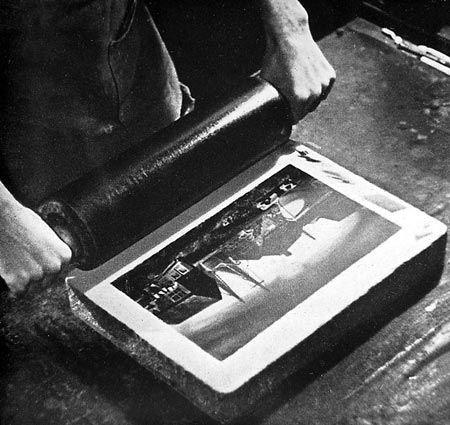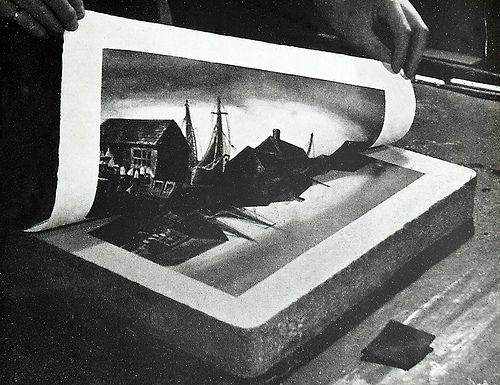Lithography
Lithography is a printmaking technique that involves creating images on a flat surface, typically a stone known as limestone or metal plate, with a greasy or oily substance. The surface is then chemically treated to make the image areas receptive to ink, while the non-image areas repel the ink.
The process begins by drawing directly onto the prepared surface using special lithographic crayons or inks. After the image is completed, it is treated with a fixative to help it adhere to the surface. Next, the surface is moistened with water, which is absorbed by the non-image areas but repelled by the greasy image areas.
Ink is then applied to the surface using a roller, adhering only to the greasy image areas. Finally, a sheet of paper is placed on top of the inked surface and passed through a printing press, transferring the image onto the paper.
The process of lithographs allows for the creative artistic expression of intricate and detailed prints from precise line work to rich tonal variations with a wide range of textures. It’s a versatile technique often used in fine art, and commercial printing and it has been used by many famous artists throughout history, including Honore Daumier, Henri Toulouse-Lautrec, and Alphonse Mucha.
History of Lithography
The history of lithography art is a fascinating journey that began in the late 18th century and continues to evolve today, Here’s a brief overview:
Invention by Alois Senefelder Late 18th Century
Lithographs were invented in 1796 by Alois Senefelder, a German playwright and actor. Seeking a more cost-effective method for publishing his theatrical works, Senefelder experimented with various materials and techniques. He discovered that limestone could be used to transfer images onto paper by exploiting the chemical principle of oil and water repulsion.
Early Developments Early 19th Century
Senefelder’s invention quickly gained popularity among artists and printers due to its versatility and affordability. The ability to create detailed images on flat surfaces appealed to artists, while printers appreciated the cost-effectiveness of the process compared to traditional methods like engraving or etching.
Rise of Commercial Lithography Mid-19th Century
By the mid-19th century, lithographs had become a widely used commercial printing technique. Its ability to produce high-quality reproductions made it ideal for printing posters, advertisements, sheet music, and newspapers. Lithographic posters, in particular, became popular for advertising everything from theatrical performances to consumer products.
Artistic Adoption Late 19th Century
In addition to its commercial applications, lithography also gained recognition as a fine art medium. Artists like Honoré Daumier and Henri de Toulouse-Lautrec embraced lithography for its ability to reproduce their drawings and paintings with remarkable fidelity. Lithographs allowed artists to reach a broader audience and disseminate their work more widely.
20th Century and Beyond
Lithography continued to evolve in the 20th century with the development of new techniques and materials. Artists experimented with color lithography printing, photolithography, and other innovative processes to push the boundaries of the medium. Lithography remains a popular printmaking technique today, valued for its versatility, expressive potential, and historical significance.
The history of lithography printmaking is one of innovation, creativity, and adaptation. From its humble beginnings as a cost-effective printing method to its widespread use in both commercial and fine art contexts, lithography has left an indelible mark on the history of printmaking and continues to inspire artists and printers around the world.
What is Lithography Printing Process?
The lithography process is a complex yet fascinating technique that involves several steps to create high-quality prints.
Preparation of the Surface
The process begins with preparing a smooth, flat surface, traditionally made of limestone but nowadays often using metal plates. The surface is grained to create a fine texture that will hold the drawing materials.
Drawing or Image Creation
Using grease-based materials such as lithographic crayons or ink, the artist creates the desired image directly onto the prepared surface. The greasy medium adheres to the surface, forming a positive image.
Chemical Treatment
Once the drawing is complete, the entire surface is treated with a chemical solution, typically a mixture of gum arabic and acid. This solution bonds to the non-image areas, making them hydrophilic (water-attracting), while the greasy image areas remain hydrophobic (water-repelling).
Inking
The surface is then moistened with water, which is repelled by the greasy image areas but adheres to the non-image areas. Next, an oil-based ink is applied to the surface using a roller, covering the entire surface evenly.

Lithography Printing
A sheet of paper is carefully placed on the inked surface, and the two are run through a printing press under high pressure. The pressure forces the ink from the image areas onto the paper, creating a mirror image of the original drawing.

Repeating the Process
Depending on the desired number of prints, the process may be repeated multiple times, with the surface cleaned and re-inked for each and every print.
Drying and Finishing
Once the print is complete, it is allowed to dry thoroughly. Depending on the desired finish, the print may undergo additional treatments such as varnishing or embossing.
The lithography printing process is a lot different and way more complex than other printmaking techniques and processes, it combines artistic skill with chemical principles to produce prints with intricate details, rich textures, and subtle tonal variations. Its versatility and ability to reproduce high-quality images have made it a popular choice among artists and printmakers for centuries.